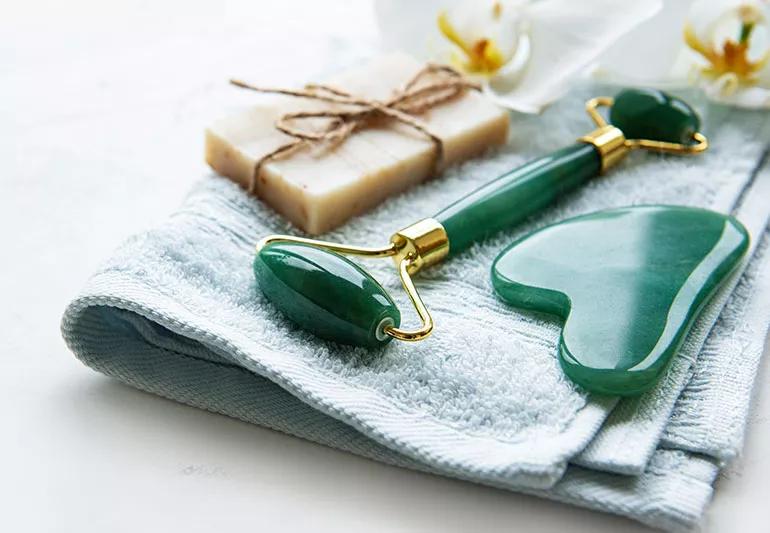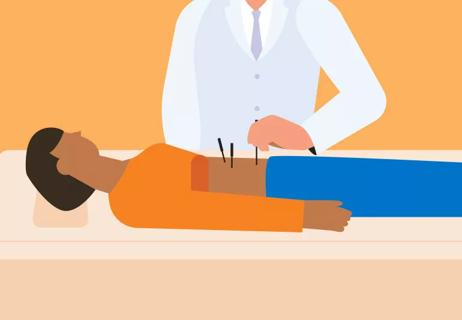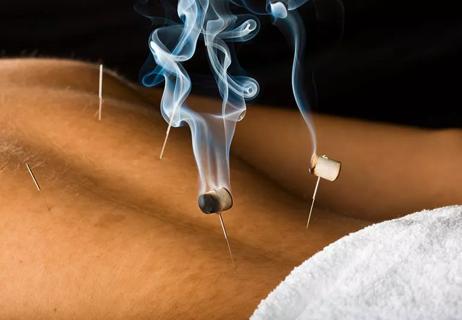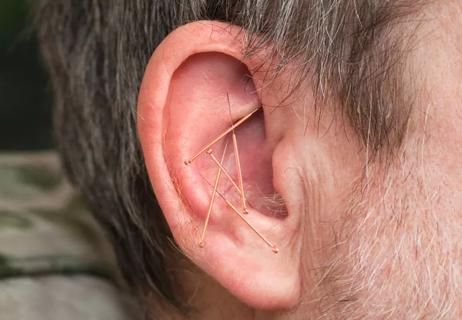Find out what it is and how it can help the body heal

You can find a lot of wonderful things on social media — and a lot of questionable things, too. Gua sha isn’t one of those questionable things. While it might look like something that you’d see in a late-night infomercial, this time-honored muscular scraping technique boasts many benefits. Licensed acupuncturist Tim Sobo, LAc, explains what gua sha is and offers some helpful tips for ensuring that your experience is satisfying and not scary.
Advertisement
Cleveland Clinic is a non-profit academic medical center. Advertising on our site helps support our mission. We do not endorse non-Cleveland Clinic products or services. Policy
Gua sha is rooted in traditional Chinese medicine (TCM). According to the principles of TCM, your qi (pronounced “chi”), or energy, must flow throughout your body so you can feel your best. When qi becomes stagnant in certain areas, it’s believed that health problems can occur. With gua sha, a practitioner (an acupuncturist in many cases) will use a smooth-edged tool to gently scrape areas of your body where there is inflammation or stagnant qi to help improve circulation and promote healing.
“Gua sha is a very standard kind of treatment modality that most acupuncturists will use. Its meaning loosely translates to ‘scraping, rubbing or pushing.’ Essentially, gua sha is just a tool-assisted type of massage,” explains Sobo.
Physical therapists sometimes incorporate muscle scraping to stretch and relax muscles or scar tissue. While this is pretty much gua sha, it’s known as the Graston Technique® in the industry. In 1990, David Graston, an amateur athlete, introduced his version of gua sha to the United States. Sobo says that while qi is associated more with gua sha, both muscle scraping methods are about the same.
“The Graston Technique is just a trademarked version of the gua sha massage technique. The difference is that you get Graston from a physical therapist. They’re going to talk about the technique entirely in anatomical or physiological terminology. If you go to a very strict acupuncturist, you’ll probably hear more about promoting qi and blood circulation and helping to break up the stagnation of energy in your body. But at the end of the day, both therapies have the same goal outcome.”
Advertisement
Sobo adds that while acupuncturists are trained in gua sha, it’s not always offered during acupuncture sessions. This could come down to it not making sense for the areas of the body being treated or an acupuncturist just opting not to do it. But if you’re interested in experiencing gua sha, you can always request it when making your appointment.
Reading that gua sha involves “scraping,” might make you cringe. However, a practitioner won’t be scraping your body like a car windshield in the middle of winter. Gua sha is gentle overall, and the intensity can build depending on the types of knots that your acupuncturist encounters.
Sobo gives us a better idea of how it works.
“Gua sha tools have smooth, rounded edges. They’re not going to cut, stab or pinch you. Before your acupuncturist starts, they’ll massage the treatment area with cream or lotion first and then take things to your comfort level. An acupuncturist won’t just dig in as hard as they can right away on a point. They’re going to find the tense tissue, work on it gently and gradually build up the intensity to promote circulation to help break up the areas that are all twisted up.”
It’s been reported that gua sha can help relieve several health conditions. Sobo says that gua sha is good for musculoskeletal problems, especially major ones like tightness in the shoulders, legs and back. It can also help alleviate tension headaches, migraines, neck pain or swelling in your body. Sobo adds that gua sha can even help with anxiety, fatigue, insomnia and perimenopausal symptoms when done in addition to acupuncture.
“We’re just promoting that flow of qi through the body. We’re helping to ensure a better blood supply and proper nerve conduction so that everything is moving through your body as it should. In doing gua sha, the hope is that any symptoms you’re experiencing will subside. That’s the overall goal.”
He adds: “With gua sha, acupuncture and TCM, we look at a host of illnesses. If you don’t have that smooth flow of blood and energy throughout your body, it can manifest as muscle knots, soreness, weakness or pain. Acupuncture along with gua sha is just going to help promote that blood supply and the conduction of everything through the tissues healthily so we can get your body as homeostatic as possible.”
Sobo says gua sha for the body is tissue-dependent, meaning you want to work in a way that supports treatment goals.
“If you have a muscle knot, you want to start by going across it with your gua sha tool. You’ll want to work perpendicular to the muscle fibers so you can break up all of the adhesions. Then, you want to go in the direction of the muscle fibers to lengthen and get them in the correct direction again. With those painful knots in your upper shoulders, you want to go back and forth across them with your tool to break the knots up. Once things start to loosen up, you’ll start moving your gua sha tool in the direction of the muscle fibers, which is usually inwards to outwards. However, you don’t want to start gua sha in this direction because you’ll only make the tissue tighter.”
Advertisement
You’ve probably seen people rubbing gua sha stones across their faces on social media and wondered what was going on. Gua sha has been proven to help relieve tension in the face, reduce puffiness and inflammation, and it can even help reduce sinus pressure. However, since the musculature of the face is much thinner, you’ll want to avoid applying too much pressure as you’re working on this area.
“Generally, the musculature of the face is very thin and it doesn’t bulge up the same way as other muscles do. With gua sha on the face, you don’t want to drag your tool from the outside edges of your face. Instead, divide your face in half and use your nose as the middle point. If you’re working under your eyes, you’d start at your nose and work your gua sha tool outward. Keep your tool moving in a smooth, straight line. Don’t rub your gua sha tool back and forth, up and down, and in all different angles vigorously because that’s going to just stretch and aggravate the skin. Keep things going in one smooth direction, and do it enough to get a little redness to form, but not so much that it hurts.”
To help things along, you can even apply lotion or a serum before doing gua sha on your face. This way, your tool will glide across the skin much easier. Sobo suggests avoiding overly swollen areas. You don’t want to press too hard into those because you can burst capillary beds and end up with bruises on your face.
Advertisement
According to Sobo, you can go simple with a small wooden spoon or you can get a gemstone gua sha tool. Whatever you choose, keep it clean and in good condition.
“There’s no clinical difference between one versus the other. You just want to get a tool that you can easily clean and maintain. And if it chips or breaks, which it shouldn’t do but it can, you’ll want to stop using it. If you get a little gash in a jade gua sha face tool, you don’t want to rub that all over your face.”
Sobo says you always want to work with a clean tool. He adds that some tools can be cleaned in boiling water or with a watered-down bleach solution.
Most people should be able to tolerate gua sha well, but if you have problems with your circulation or have diabetes, let your practitioner know before your session starts. That way, they’ll know to adjust the pressure to prevent any potential issues.
While you might think that gua sha would be too much for someone who has peripheral neuropathy, Sobo says it’s not. He adds that when done in conjunction with acupuncture, gua sha can help promote blood flow for those with peripheral neuropathy. But if you’re on blood thinners, your practitioner should either avoid doing gua sha or do it very gently so they don’t break up too many blood vessels.
Advertisement
If you’re new to acupuncture and gua sha, you might not know what to expect when it comes to the intensity of these services. Know right off the bat that these services should not hurt or leave you bruised. If you find yourself digging your nails into the table or tensing up a great deal at any point during your session, you need to let the practitioner know immediately so they can adjust accordingly.
“You have to be comfortable saying, ‘Ouch that hurts,’ because the acupuncturist won’t know if you don’t tell them. At the same time, the acupuncturist needs to explain to you that if you’re in pain, you’re not getting a beneficial treatment. They’re trying to loosen things up. If it hurts too much, you’re just going to tighten up more and the acupuncturist is just going to be running around in circles as they’re trying to get you to feel better. So in order for you to get relief, everyone needs to be on the same page.”
Learn more about our editorial process.
Advertisement

This evidence-based practice is used to help manage pain, relieve menopause symptoms and boost your spirits

It’s great for stress relief, which can go a long way when you’re trying to conceive

This ancient treatment is often a complement to acupuncture

Discover the benefits of this ear acupuncture technique

New government advisory recommends non-addictive options first

Find relief by keeping a neutral spine, trying a medium-firm mattress and using pillows for support

Taking a stand throughout the day can lower your risk of disease while improving your energy, focus and productivity

Weightlifting and other types of resistance training bring many health benefits

If you’re feeling short of breath, sleep can be tough — propping yourself up or sleeping on your side may help

If you fear the unknown or find yourself needing reassurance often, you may identify with this attachment style

If you’re looking to boost your gut health, it’s better to get fiber from whole foods